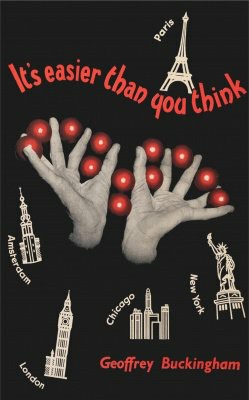This is a digital edition of the first edition of this book. It has wonderful photos. The later edition in three volumes published by Magic Inc. replaced the photos with line drawings. The book captures Buckingham’s manipulation moves and routines for billiard balls, coins, and thimbles. It has practical advice from a successful pro and is perhaps the finest book on this subject ever published.
Here is the text from the inside flaps of the first edition:
When did you first become interested in Magic? Almost every magician is asked this question at one time or another, and the reply is usually, “Oh! when I was a boy at school.”
It is doubtful if Geoffrey Buckingham had any thoughts in that direction as a schoolboy because he will tell you that he was well into his twenties before he was bitten by “the magic bug” – but then he was bitten good and hard. Born in 1902 into a musical family, his early years of practice were spent at the piano keyboard. At the age of eighteen, he was an assistant church organist with a passion for becoming an accomplished performer on that instrument.
Then, just a few years later, as a result of a casual introduction by a friend to Nelson Downs’ book on coin manipulation, music gave way to magic almost overnight.
Following the usual period of “apprenticeship,” Geoffrey was soon giving up to a dozen shows a week in the season, at dinners, concerts, and children’s parties, in addition to following his regular employment as an engineering draughtsman. In this hard school, where one must be capable of giving a performance under almost any conditions, he acquired his extensive experience and knowledge of the business of magical entertainment. Always having a liking for hand magic, he was, during this time, almost unbeknown to the magical world, quietly building up his now famous manipulative act.
In 1949, having become interested for the first time in competitive magic, and the joys of a magical convention, he decided to attend the International Congress held that year in Amsterdam, and “have a go.” The result – first prizes in two classes – manipulation and close-up magic, a feat so far unequaled at any International Congress. Then followed the American tour in 1950, as a member of Goodliffe’s party of “Flying Sorcerers,” and in 1951, he won the highest award magic has to offer, the International Grand Prix, in Paris.
Now having attained executive status in business, magic remains his absorbing interest in his free time. On the stage, Geoffrey Buckingham works alone. “Behind the scenes” he has a partner – his wife. With a knowledge and love of magic as great as his own, he includes in the act nothing that has not passed her severe but constructive criticism. She has always watched most of his rehearsals, and is now sometimes joined by their eight-year-old twin son and daughter, who, with characteristic disregard for parental fame, have been known to murmur, “Daddy! we saw how you did that one.” Which only goes to show “IT’S EASIER THAN YOU THINK.”
Contents
Introduction
Chapter One Manipulations Made Magic
Chapter Two The Aerial Treasury
Chapter Three The Multiple Back-Palm Production Of Coins
Chapter Four Miscellaneous Coin Sleights And Flourishes
Palming
The Coin Roll
The Human Coin Ladder
The Coin Spread
Chapter Five The Miser’s Dream In Cabaret
Chapter Six The Multiplying Billiard Balls
An Eight Ball Production
Chapter Seven A Ten And Twelve Ball Production
Chapter Eight Miscellaneous Flourishes With Billiard Balls
The Finger Roll
The One-Handed Finger Roll
The Two-Ball Palm Roll
Catching Between The Fingers
The Two-Ball Tumble
Chapter Nine Loading And Stealing
Direct Loads From The Body
Pick-Up Loads From The Body
Substitution Loads
Chapter Ten Holders For The Manipulator
Coin Holders
The Elastic Belt
Billiard Ball Holders
The Waistband Holder
Inverted Trousers Pocket Holders
Thimble Holders
Holders On A Jacket
General Remarks
Chapter Eleven Thimble Manipulation A New Technique
Single Thimble Palming
Multiple Palming
Separate Palming And Recovery
Instantaneous Production Of Ten Thimbles
The Finger Change
The Finger Change – Another Method
Vanish And Instantaneous Production Of Four Thimbles
Chapter Twelve The Dancing Thimbles
A Novelty Thimble Routine
Chapter Thirteen The Final Word
The Move
The Routine
Practice And Rehearsal
The Great Moment




